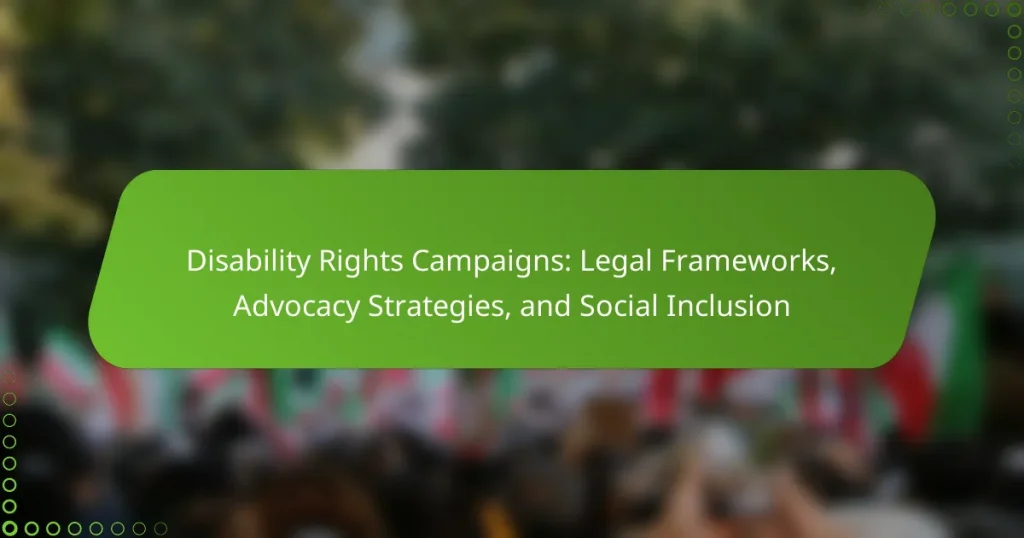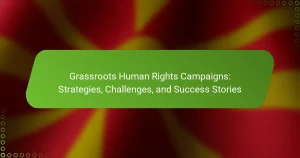Disability Rights Campaigns are organized efforts aimed at advocating for the rights and inclusion of individuals with disabilities. These campaigns focus on raising awareness about discrimination and promoting equal access to opportunities, often targeting legal reforms, policy changes, and shifts in social attitudes. Key strategies include protests, lobbying, and public education, with historical milestones like the Americans with Disabilities Act of 1990 highlighting their impact. Future directions emphasize enhancing legal protections, addressing systemic barriers, and fostering collaboration with other social justice movements to create a more inclusive society. The article will explore the legal frameworks, advocacy strategies, and the importance of social inclusion in the context of Disability Rights Campaigns.
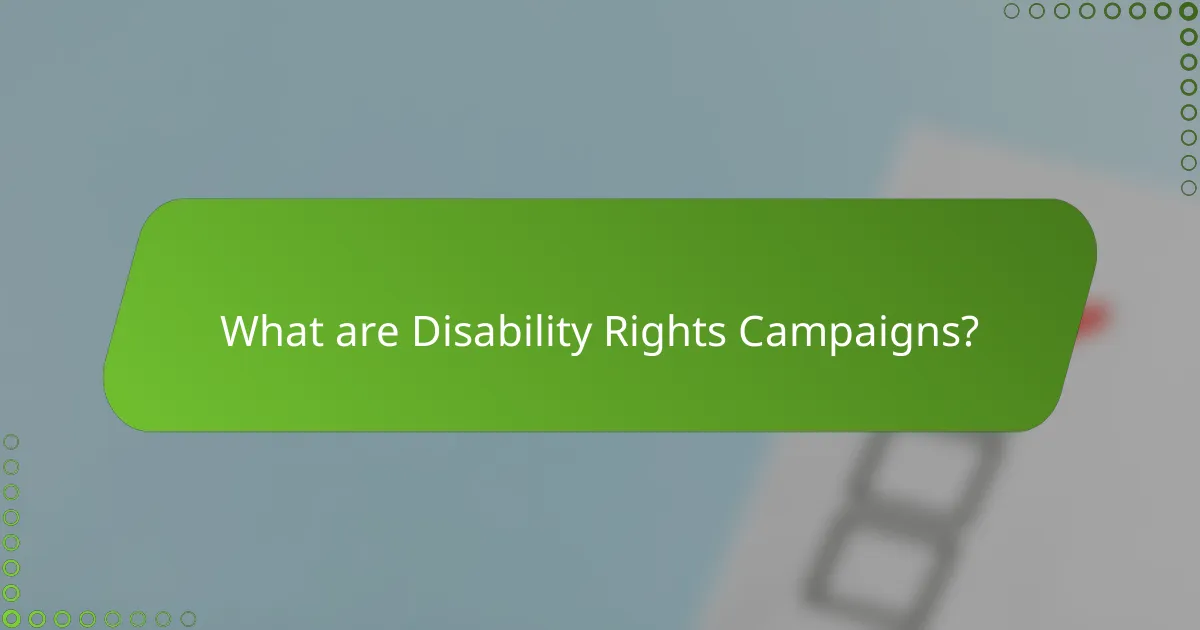
What are Disability Rights Campaigns?
Disability rights campaigns are organized efforts to advocate for the rights and inclusion of individuals with disabilities. These campaigns aim to raise awareness about discrimination and promote equal access to opportunities and resources. They often focus on legal reforms, policy changes, and social attitudes. Campaigns can be local, national, or international in scope. They utilize various strategies, including protests, lobbying, and public education. Historical milestones, such as the Americans with Disabilities Act of 1990, exemplify the impact of these efforts. Statistics indicate that effective campaigns can lead to significant improvements in the quality of life for disabled individuals.
How do Disability Rights Campaigns impact society?
Disability rights campaigns significantly impact society by promoting equality and inclusion for individuals with disabilities. These campaigns raise awareness about the challenges faced by disabled individuals. They advocate for legislative changes that protect and enhance the rights of these individuals. For instance, the Americans with Disabilities Act (ADA) of 1990 was a direct result of such advocacy efforts. This law prohibits discrimination based on disability in various areas, including employment and public accommodations. Moreover, disability rights campaigns foster community support and change public perceptions. They encourage society to recognize the abilities and contributions of disabled individuals. Research shows that inclusive policies lead to improved social outcomes for everyone. Overall, disability rights campaigns are essential for advancing social justice and equity.
What are the historical milestones in Disability Rights Campaigns?
The historical milestones in Disability Rights Campaigns include key legislative and social changes that have shaped the rights of individuals with disabilities. The Rehabilitation Act of 1973 was one of the first significant laws prohibiting discrimination based on disability in federally funded programs. The Americans with Disabilities Act (ADA), enacted in 1990, provided comprehensive civil rights protections for individuals with disabilities in various areas, including employment and public services. In 1999, the Supreme Court’s Olmstead decision affirmed the right of individuals with disabilities to live in the community rather than institutions. The Individuals with Disabilities Education Act (IDEA), first passed in 1975 and reauthorized multiple times, ensured that children with disabilities have access to free and appropriate public education. The UN Convention on the Rights of Persons with Disabilities, adopted in 2006, marked a global commitment to uphold the rights of disabled individuals. These milestones collectively reflect the ongoing struggle for equality and inclusion in society.
How do these campaigns influence public perception of disability?
Disability rights campaigns significantly influence public perception of disability by promoting awareness and understanding. These campaigns often highlight the capabilities and contributions of individuals with disabilities. They challenge stereotypes and stigmas associated with disabilities through positive messaging and representation. For instance, campaigns like the “Nothing About Us Without Us” movement emphasize inclusion and self-advocacy. Research shows that increased visibility of disabled individuals in media correlates with more favorable public attitudes. A study by the National Organization on Disability found that such campaigns can lead to a 30% increase in public support for disability rights initiatives. Overall, these campaigns reshape narratives around disability, fostering a more inclusive society.
What legal frameworks support Disability Rights Campaigns?
The legal frameworks that support Disability Rights Campaigns include the Americans with Disabilities Act (ADA) and the Individuals with Disabilities Education Act (IDEA). The ADA prohibits discrimination against individuals with disabilities in various areas such as employment and public accommodations. The ADA was enacted in 1990 and has been pivotal in ensuring equal rights. IDEA mandates that public schools provide free appropriate education to students with disabilities. This act emphasizes the importance of individualized education plans. Additionally, the Rehabilitation Act of 1973 prohibits discrimination in federally funded programs. These frameworks provide essential protections and promote inclusion.
What are the key laws and regulations governing disability rights?
The key laws and regulations governing disability rights include the Americans with Disabilities Act (ADA) and the Rehabilitation Act of 1973. The ADA prohibits discrimination against individuals with disabilities in various areas, including employment, public services, and accommodations. The Rehabilitation Act specifically addresses the rights of individuals with disabilities in federal programs and activities. Section 504 of this act ensures that no qualified individual with a disability is denied benefits or subjected to discrimination under any program receiving federal financial assistance. The Individuals with Disabilities Education Act (IDEA) mandates that children with disabilities receive free appropriate public education tailored to their individual needs. These laws collectively promote equal opportunities and protect the rights of individuals with disabilities across multiple sectors.
How do international treaties affect national disability rights legislation?
International treaties shape national disability rights legislation by establishing standards and obligations for signatory countries. These treaties, such as the Convention on the Rights of Persons with Disabilities (CRPD), provide frameworks that promote equality and inclusion. They require nations to align their laws with the principles outlined in these agreements. For instance, the CRPD mandates accessibility, non-discrimination, and participation in society for individuals with disabilities. Countries often amend their legislation to comply with these international norms. This alignment can lead to improved legal protections and access to services for people with disabilities. Additionally, international treaties can influence public policy and raise awareness about disability rights.
What advocacy strategies are employed in Disability Rights Campaigns?
Disability Rights Campaigns employ various advocacy strategies to promote equality and accessibility. These strategies include grassroots organizing, which mobilizes individuals at the community level to raise awareness and advocate for change. Legal advocacy is another key strategy, focusing on litigation and policy reform to protect the rights of individuals with disabilities. Public awareness campaigns aim to educate the general public about disability issues and combat stereotypes. Coalition building is also vital, as it brings together diverse organizations to strengthen the movement. Additionally, lobbying government officials helps influence policy decisions that affect the disabled community. Research indicates that these strategies collectively enhance the effectiveness of disability rights movements (Disability Rights Education and Defense Fund, 2020).
How do grassroots movements contribute to advocacy efforts?
Grassroots movements significantly enhance advocacy efforts by mobilizing community support and raising awareness. They engage individuals directly affected by issues, fostering a sense of ownership and urgency. This localized approach often leads to increased participation in campaigns. For example, grassroots initiatives can inform policymakers about the specific needs of disabled individuals. Research shows that grassroots advocacy can lead to legislative changes, as seen in the Americans with Disabilities Act of 1990. Studies indicate that community-driven efforts result in more tailored and effective advocacy strategies. Overall, grassroots movements create a powerful platform for collective action and influence in disability rights campaigns.
What role do non-profit organizations play in these campaigns?
Non-profit organizations play a crucial role in disability rights campaigns. They advocate for policy changes to promote inclusion and accessibility. Non-profits often provide resources and support for individuals with disabilities. They raise awareness through educational programs and community outreach. These organizations mobilize volunteers and resources to amplify their impact. They also collaborate with governmental and private entities to influence legislation. Research shows that non-profits significantly enhance the visibility of disability issues. Their efforts lead to improved legal protections and social acceptance for people with disabilities.
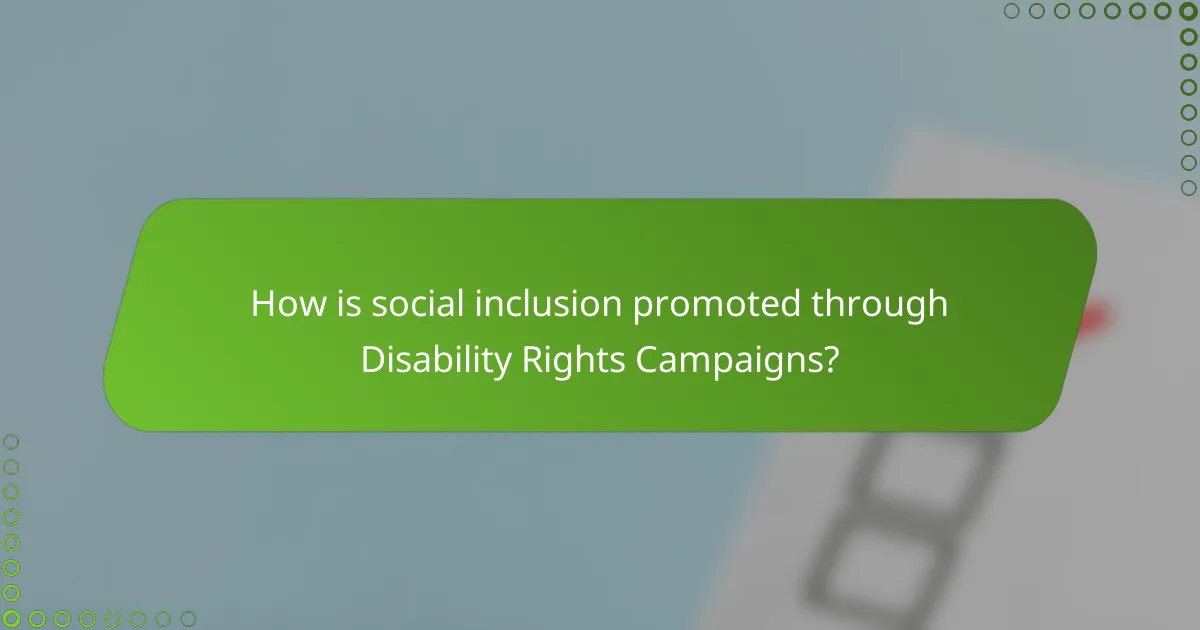
How is social inclusion promoted through Disability Rights Campaigns?
Disability Rights Campaigns promote social inclusion by advocating for equal rights and accessibility for individuals with disabilities. These campaigns raise awareness about the barriers faced by disabled individuals. They often focus on policy changes to ensure compliance with disability rights laws. Campaigns also encourage community engagement and participation in decision-making processes. They highlight the importance of inclusive education and employment opportunities. By fostering a culture of acceptance, these campaigns combat stigma and discrimination. Research shows that inclusive policies lead to better social outcomes for individuals with disabilities. Overall, Disability Rights Campaigns play a crucial role in creating a more inclusive society.
What are the main barriers to social inclusion for individuals with disabilities?
The main barriers to social inclusion for individuals with disabilities include physical accessibility, social stigma, and lack of support services. Physical accessibility refers to the inadequate infrastructure that prevents individuals from accessing public spaces. For instance, many buildings lack ramps or elevators, making it difficult for those with mobility impairments to enter. Social stigma encompasses negative perceptions and attitudes towards disabilities, which can lead to exclusion from social activities. Research indicates that individuals with disabilities often face discrimination, limiting their opportunities for engagement. Lack of support services includes insufficient resources like transportation, assistive technologies, and personal assistance, which are essential for participation in community life. These barriers collectively hinder the ability of individuals with disabilities to fully engage and integrate into society.
How can campaigns effectively address these barriers?
Campaigns can effectively address barriers by employing targeted advocacy strategies. These strategies include raising awareness about disability rights and promoting inclusive policies. Campaigns should engage with affected communities to understand their specific needs. Utilizing data and personal stories can strengthen the campaign’s message. Collaborating with legal experts ensures campaigns align with existing laws. Providing accessible resources helps empower individuals with disabilities. Regularly evaluating campaign effectiveness allows for adjustments based on feedback. Research shows that inclusive campaigns can lead to increased public support and policy change.
What role does public awareness play in promoting social inclusion?
Public awareness is crucial for promoting social inclusion. It educates the community about the challenges faced by marginalized groups. Increased awareness leads to greater empathy and understanding. This shift in perception can reduce stigma and discrimination. Studies show that informed communities are more likely to support inclusive policies. For example, campaigns that highlight disability rights have successfully increased public support for accessibility initiatives. Furthermore, awareness initiatives often encourage individuals to engage in advocacy efforts. This active participation fosters a culture of inclusion and belonging.
What are the outcomes of successful Disability Rights Campaigns?
Successful Disability Rights Campaigns lead to increased legal protections for individuals with disabilities. These campaigns often result in the enactment of laws like the Americans with Disabilities Act (ADA) in 1990. They promote greater accessibility in public spaces and services. Awareness of disability rights is significantly raised through advocacy efforts. This increased awareness fosters societal acceptance and reduces stigma. Successful campaigns also improve access to education and employment opportunities. Statistics show that employment rates for individuals with disabilities improve following successful advocacy. These outcomes contribute to enhanced quality of life for people with disabilities.
How do these campaigns improve access to education and employment?
Disability rights campaigns improve access to education and employment by advocating for inclusive policies and practices. These campaigns push for legal frameworks that ensure equal opportunities for individuals with disabilities. They promote awareness and understanding of disability issues among educators and employers. Increased training and resources for educators lead to better support for students with disabilities. Employers are encouraged to adopt inclusive hiring practices through advocacy efforts. Statistics show that inclusive workplaces can increase productivity and employee satisfaction. Furthermore, these campaigns often provide direct support services that facilitate access to education and job training programs. By addressing systemic barriers, they create a more equitable environment for all individuals.
What changes in policy and legislation have resulted from these campaigns?
Disability rights campaigns have led to significant changes in policy and legislation. The Americans with Disabilities Act (ADA) of 1990 is a landmark result, prohibiting discrimination based on disability in various sectors. The Individuals with Disabilities Education Act (IDEA) was also reauthorized, enhancing educational rights for children with disabilities. The Rehabilitation Act of 1973 was amended to strengthen provisions for vocational rehabilitation services. Additionally, the Affordable Care Act expanded access to healthcare for individuals with disabilities. These legislative changes reflect the ongoing advocacy for equal rights and inclusion in society.
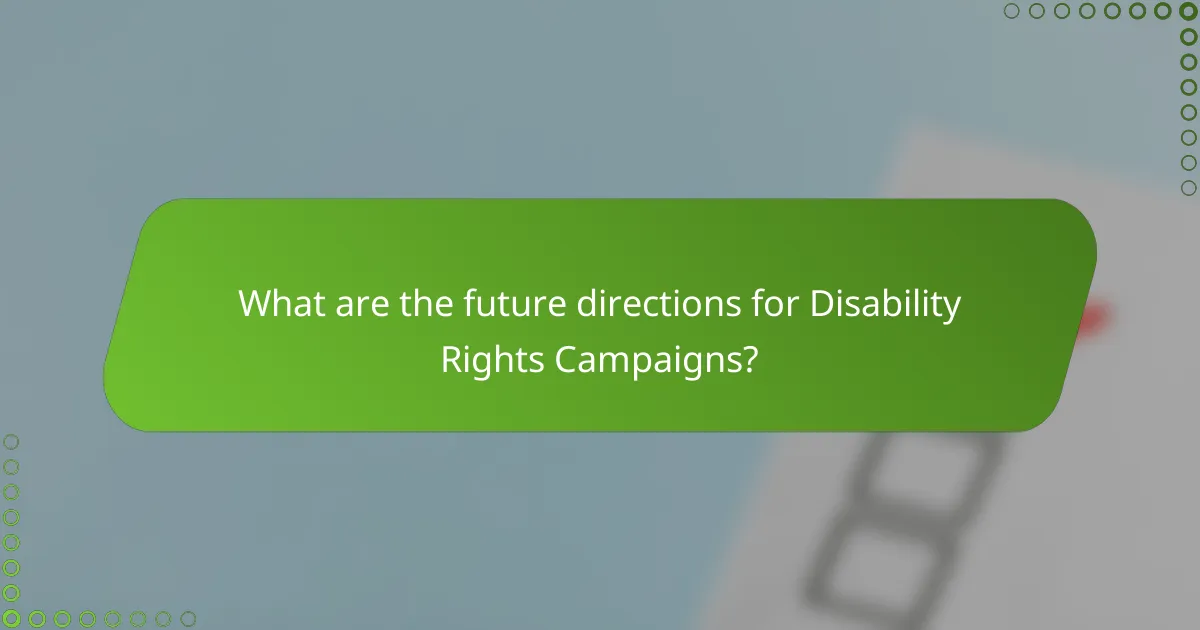
What are the future directions for Disability Rights Campaigns?
Future directions for Disability Rights Campaigns focus on enhancing legal protections and promoting social inclusion. Advocacy efforts will increasingly target systemic barriers faced by individuals with disabilities. Campaigns will prioritize intersectionality, addressing the diverse experiences of disabled individuals across various demographics. Technology will play a crucial role in improving accessibility and communication. Collaboration with other social justice movements will strengthen advocacy efforts. Data-driven approaches will help measure the impact of campaigns and inform strategies. Increased public awareness and education will foster a more inclusive society. Engaging disabled voices in decision-making processes will ensure campaigns remain relevant and effective.
How can technology enhance advocacy efforts in Disability Rights Campaigns?
Technology enhances advocacy efforts in Disability Rights Campaigns by increasing visibility and engagement. Digital platforms allow advocates to reach broader audiences quickly. Social media campaigns can raise awareness and mobilize support effectively. Online petitions can gather signatures and demonstrate public support for disability rights. Assistive technologies improve communication for individuals with disabilities, empowering them to voice their needs. Data analytics can track campaign impact and audience engagement in real-time. Virtual events can connect advocates and stakeholders globally, fostering collaboration. Overall, technology streamlines advocacy efforts, making them more efficient and impactful.
What innovative strategies are emerging in the field of disability advocacy?
Innovative strategies emerging in disability advocacy include the use of technology for awareness and accessibility. Digital platforms facilitate connections among advocates and the disabled community. Social media campaigns raise awareness and foster community engagement. Virtual reality tools provide immersive experiences to illustrate challenges faced by individuals with disabilities. Data analytics help organizations measure impact and tailor advocacy efforts. Partnerships with private sectors enhance resource availability and support. Legislative advocacy is increasingly data-driven, focusing on measurable outcomes. These strategies reflect a shift towards inclusive practices and empower individuals with disabilities.
What best practices should be considered for effective Disability Rights Campaigns?
Effective Disability Rights Campaigns should prioritize inclusive messaging and community engagement. Campaigns must ensure that the voices of people with disabilities are central to the narrative. Utilizing accessible communication methods is crucial for reaching diverse audiences. Collaborating with disability organizations enhances credibility and outreach. Clear goals and measurable objectives guide campaign efforts effectively. Data-driven advocacy can demonstrate the need for change and influence policy. Continuous evaluation and adaptation of strategies ensure responsiveness to community needs. Legal frameworks should be referenced to strengthen arguments and support claims.
How can collaboration among stakeholders enhance campaign effectiveness?
Collaboration among stakeholders enhances campaign effectiveness by leveraging diverse expertise and resources. Stakeholders, including advocacy groups, government bodies, and community organizations, bring unique perspectives. This diversity fosters innovative solutions tailored to specific challenges in disability rights. Joint efforts improve outreach and engagement, reaching a broader audience. Collaborative campaigns can pool funding, increasing financial resources for initiatives. Research shows that campaigns with multi-stakeholder involvement achieve higher success rates. For example, the National Disability Rights Network reported increased legislative support through collaborative advocacy efforts. Enhanced communication among stakeholders ensures consistent messaging, strengthening campaign impact. Overall, collaboration maximizes the potential for meaningful change in disability rights.
What lessons can be learned from past campaigns to guide future efforts?
Past disability rights campaigns provide critical lessons for future efforts. Successful campaigns highlight the importance of coalition-building among diverse stakeholders. For example, the Americans with Disabilities Act (ADA) mobilized various advocacy groups to achieve legislative change. Effective messaging is another key lesson. Campaigns that resonate emotionally tend to garner more public support. The “Nothing About Us Without Us” slogan emphasizes the need for inclusive representation in advocacy. Additionally, utilizing data to demonstrate the impact of disability rights can strengthen arguments. The 2017 Disability Statistics Annual Report showed that 61 million adults in the U.S. live with a disability, underscoring the need for continued advocacy. Lastly, persistence is vital. Many successful initiatives took years of sustained effort to achieve their goals. These lessons can guide future disability rights campaigns towards more effective strategies and outcomes.
Disability rights campaigns are organized efforts aimed at advocating for the rights and inclusion of individuals with disabilities, focusing on raising awareness, promoting equal access, and effecting legal reforms. This article outlines the historical milestones, legal frameworks, and advocacy strategies that shape these campaigns, including key legislation like the Americans with Disabilities Act and the Individuals with Disabilities Education Act. It also examines the impact of these campaigns on public perception, social inclusion, and the barriers faced by disabled individuals, while highlighting the role of grassroots movements and non-profit organizations in driving change. Furthermore, the article discusses future directions for disability rights advocacy, emphasizing the importance of technology and collaboration among stakeholders to enhance effectiveness.
